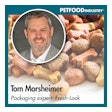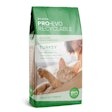
It’s a subject Golladay knows well. After rebranding five years ago with the help of Ideas that Kick, Ohio Pet Foods has been on a growth pattern of more than 10% per year. Such a number typifies the kind of results every company hopes to achieve when they begin to discuss updating their branding strategy, but not every company knows where to begin—or where to initially focus.

The Blackwood brand underwent a significant overhaul five years ago with the help of Ideas that Kick. (Pictured: the old brand, right, and the new brand, left.)
“The most common goal is for people to determine how they can gain more market space, and how they can grow as a company, whether that’s with their existing audience or new audiences,” says Hartung. “The second big thing that I’m seeing is expanding internationally—how do you set yourself up for that from a strategy point of view and from a logistic point of view?” In human food, according to Hartung, the biggest opportunity seen after a repackaging campaign is an almost immediate increase in sales. Changing a company’s packaging to a new, fresh look has a significant impact in the first six months. “It’s the reason why cereal companies do a lot of rebranding all the time,” he says.
Certain demographics of shoppers can also have a significant impact on the reasons for rebranding. According to Hartung, Millennials aren’t brand loyal in the same way as older generations, so it’s important for brands to establish themselves and then continue to provide a fresh look in order to stay on shoppers’ radars. “One of the biggest fears we hear from clients who approach us is that the retailer and consumer won’t understand the change,” says Hartung. Companies find themselves asking the same questions: Will customers stick with the brand once it’s been revamped, or move on? Will consumers understand any new directions in which the brand goes? Will the marketing be successful?
There are certain steps Ideas that Kick takes to alleviate these anxieties, and the first step involves starting at the very beginning and information gathering, according to Hartung. The company sits down with its clients and takes a look at all equities: current logos, brands, pet food packaging, anything that might be due for some work. Together, they decide what to keep and what to change, including everything from the information presented to the packaging’s color schemes. Then, it’s time for concepts. According to Hartung, his company presents ideas along the entire spectrum of possibility, from campaigns reminiscent of the existing strategies to ideas that are completely different from what the company’s currently doing. The key, he says, is to find the acceptance point of the client for change.
“I will tell clients: go to your distributors, your retailers, and get some input,” says Hartung. “You don’t necessarily have to listen to everything they say, but you can give them a preview of things to come. It gets them excited; they’re in the know and they buy into a concept a lot faster.”
There are certain things all pet food manufacturers should consider when working through a brand change, including a thorough evaluation of their packaging. “The best way for companies to approach it is to lay out what the current packaging is doing right, where there are opportunities and what they can physically do with their current equipment,” says Hartung. It must be kept in mind that equipment can actually play a role in the process, particularly if new equipment might be needed in order to accommodate new ideas.
Once short- and long-term goals are established, and a high-level strategy for approaching the market has been determined, the details can be discussed. For some clients, says Hartung, it’s more about the price. For others, it’s more about the quality; or, rather, how the quality will justify the price. Graphical language is something that clients often find more challenging than they initially anticipated. “A lot of clients know the features they want, but they forget about the emotional tie-in for the audience,” says Hartung. “Why would they actually buy this brand over another brand?”
Jumping off that comes the most important thing of all: standing out in a crowded market. Typical packaging for pet food industry leaders is all very similar, according to Hartung: a big logo, bright colors and a picture of a dog or cat—it’s practically a formula at this point. But that formula makes them all look and feel very much the same. “If you have a smaller brand, it becomes a challenge: A brand wants to be able to play on the national level and stand out,” says Hartung. “You need a view that’s different, that makes the audience look at the packaging, that connects with the audience on an emotional level and possibly also on an intellectual level. Why should they even consider this purchase? Make them feel better about the product and get the brand shelf space.”
The process feels almost intuitive, says Hartung, but it’s surprising how much rebranding can involve education. “We have to constantly re-educate our clients to pay attention to their own details,” he says. “What do they want to change? What do they want to keep? How do consumers read their packaging? How can they make it easy for retailers to sell the packages? How can they continue to apply the strategies after [the initial rebranding launch]?”
Rebranding is a multifaceted, complex process that is nevertheless vital to maintaining brand relevance in a swiftly changing market. And, as pet food consumers continue to refine their tastes in products, causing the market to become increasingly diverse in response, that relevance is key for market success.
Case study: Oxbow Animal Health
At the beginning of 2015, Oxbow Animal Health began the process of rebranding several of its products with Ideas that Kick. The company is also currently working with Ideas to rebrand its Essentials line. We asked Melissa Ross, director of marketing and education at Oxbow, about the process from Oxbow’s point of view.

Oxbow Animal Health’s rebranding strategy, which began at the start of 2015, initially focused on the company’s line of hay. (Pictured: the old brand, right, and the new brand, left.)
Q: How important was packaging as part of your rebranding strategy?
A: We knew that product packaging would be a key facet to our rebranding strategy, being a primary point of interaction with the customer. The packaging design was the best way to create a disruption in the customer’s purchasing routine, allowing us to utilize that opportunity to communicate key messages about our brand and why our products are different. We chose to start with one of our main lines—the Oxbow hay line—knowing it would be one of our most universal platforms to talk about the Oxbow Way.
Q: What were the top things you were looking for your packaging to convey?
A: First and foremost, we knew the packaging needed to convey the key attributes of each product. We started by interviewing pet owners and retailers to determine what drives purchasing decisions and what they believe are the most important attributes of our package and messaging. Their contribution to the process was extremely beneficial.
We also wanted to be sure our packaging communicated the Oxbow Way, that when you purchase an Oxbow product, you’re buying everything the Oxbow brand represents—integrity, quality, education, giveback, innovation and betterment of pets’ lives. We wanted the packaging to showcase the premium nature of our products and promote a premium experience with our brand. We wanted to reinforce the fact that we’re passionate about what we do and we’re committed to providing the best products possible, and to help pet owners understand the way we accomplish that. We wanted to evoke feeling and emotion; being part of something bigger.
Another goal was to build an overall program look across our product lines that, when merchandised together, tells our brand story and supports the Oxbow brand identity.
We also took into account retailer needs from a merchandising standpoint, and took this opportunity to address package structure improvements.
Q: In general, what role do you feel packaging plays in a branding/rebranding strategy?
A: Packaging is a key part of a branding/rebranding strategy. It’s one of your primary billboards, it oftentimes can be the principal point of interaction with a potential customer. The package is one of your best opportunities to communicate with potential customers. It plays a major part in their experience with your product and brand, from a functional standpoint as well as a messaging standpoint.
Q: What is the primary purpose of packaging as a functional entity? As a marketing opportunity?
A: The primary functional purpose obviously is to protect the product while still providing convenience to the customer. The functional components of a package can leave as important an impression with the customer as the design and message on it! They definitely play into the customer’s total experience with your product and cannot be overlooked during the development process. As a marketing opportunity, packaging creates that disruption in the customer’s purchasing routine to provide you with an opportunity to communicate the key messages about your product and brand.
Learn more at Petfood Forum 2016
Stefan Hartung and Melissa Ross will be speaking on “Rebranding pet food: strategies and success stories. For more information and to register, go to www.petfoodforumevents.com.


















